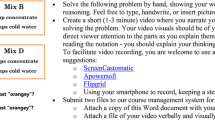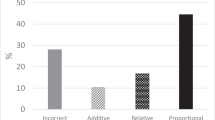Abstract
This study investigated preservice middle school mathematics teachers’ (PSTs) understanding of proportional and nonproportional relationships and their abilities to differentiate these relationships from each other. The PSTs’ abilities to interpret and represent proportional and nonproportional situations and solution strategies were also investigated. Forty PSTs who attended a mathematics education course on fractions, ratios, and proportions participated in the study. The data included the PSTs’ written responses to four open-ended problems and semi-structured interviews conducted with six of the PSTs. The analysis of the data showed that the PSTs mostly attended to the simultaneous increases or decreases and constancy of the rate of change when determining relationships. The PSTs’ over attention to these specific features constrained their understanding of the proportional and nonproportional relationships. Therefore, they had difficulty differentiating proportional relationships from nonproportional relationships even after instruction on these relationships. Moreover, some PSTs still identified nonproportional relationships as proportional after determining correct additive relationships. In addition, the PSTs had difficulty representing and interpreting proportional and nonproportional relationships and relied on cross-multiplication and across-multiplication strategies when solving the given problems.









Similar content being viewed by others
References
Arican, M. (2015). Exploring preservice middle and high school mathematics teachers’ understanding of directly and inversely proportional relationships (Unpublished doctoral dissertation). Athens, GA: University of Georgia
Arican, M. (2018). Preservice middle and high school mathematics teachers’ strategies when solving proportion problems. International Journal of Science and Mathematics Education, 16(2), 315–335.
Atabas, S. & Oner, D. (2017). An examination of Turkish middle school students’ proportional reasoning. Boğaziçi University Journal of Education, 33(1), 63–85.
Beckmann, S. (2013). Mathematics for elementary teachers. Boston: Pearson.
Beckmann, S. & Izsák, A. (2015). Two perspectives on proportional relationships: Extending complementary origins of multiplication in terms of quantities. Journal for Research in Mathematics Education, 46(1), 17–38.
Ben-Chaim, D., Keret, Y. & Ilany, B. (2007). Designing and implementing authentic investigative proportional reasoning tasks: The impact on preservice mathematics teachers’ content and pedagogical knowledge and attitudes. Journal of Mathematics Teacher Education, 10, 333–340.
Boyer, T. W., Levine, S. C. & Huttenlocher, J. (2008). Development of proportional reasoning: Where young children go wrong. Developmental Psychology, 44, 1478–1490.
Clark, H. J. (2008). Investigating students’ proportional reasoning strategies (Master’s thesis). Available from ProQuest Dissertations and Theses database. (UMI No. 1453188).
Common Core State Standards Initiative (2010). The common core state standards for mathematics. Washington, D.C.: Author.
Cramer, K. & Post, T. (1993). Making connections: A case for proportionality. Arithmetic Teacher, 60(6), 342–346.
De Bock, D., Verschaffel, L. & Janssens, D. (1998). The predominance of the linear model in secondary school students’ solutions of word problems involving length and area of similar plane figures. Educational Studies in Mathematics, 35(1), 65–83.
Degrande, T., Van Hoof, J., Verschaffel, L. & Van Dooren, W. (2017). Open word problems: Taking the additive or the multiplicative road? ZDM, 50(1–2), 91–102.
Hsieh, H. F. & Shannon, S. E. (2005). Three approaches to qualitative content analysis. Qualitative Health Research, 15(9), 1277–1288.
Hull, L. S. H. (2000). Teachers' mathematical understanding of proportionality: Links to curriculum, professional development, and support (Unpublished doctoral dissertation). Austin: The University of Texas at Austin
Izsák, A. & Jacobson, E. (2017). Preservice teachers’ reasoning about relationships that are and are not proportional: A knowledge-in-pieces account. Journal for Research in Mathematics Education, 48(3), 300–339.
Jeong, Y., Levine, S. & Huttenlocher, J. (2007). The development of proportional reasoning: Effect of continuous vs. discrete quantities. Journal of Cognition and Development, 8, 237–256.
Kilpatrick, J., Swafford, J. & Findell, B. (2001). Adding it up: Helping children learn mathematics. Washington, DC: National Academy Press.
Lamon, S. (2007). Rational numbers and proportional reasoning: Toward a theoretical framework for research. In F. K. Lester Jr. (Ed.), Second handbook of research on mathematics teaching and learning (Vol. 1, pp. 629–667). Charlotte, France: Information Age Publishing.
Lesh, R., Post, T. & Behr, M. (1988). Proportional reasoning. In J. Hiebert & M. Behr (Eds.), Number concepts and operations in the middle grades (pp. 93–118). Reston, VA: National Council of Teachers of Mathematics.
Lim, K. (2009). Burning the candle at just one end: Using nonproportional examples helps students determine when proportional strategies apply. Mathematics Teaching in the Middle School, 14(8), 492–500.
Livy, S. & Herbert, S. (2013). Second-year pre-service teachers’ responses to proportional reasoning test items. Australian Journal of Teacher Education, 38(11), 17–32.
Lobato, J. & Ellis, A. (2010). Developing essential understanding of ratios, proportions, and proportional reasoning for teaching mathematics: Grades 6–8 (pp. 20191–21502). Reston: National Council of Teachers of Mathematics.
Misailadou, C. & Williams, J. (2003). Measuring children’s proportional reasoning, the “tendency” for an additive strategy and the effect of models. In N. A. Pateman, B. J. Dougherty & J. T. Zilliox (Eds.), Proceedings of the 27th conference of the International Group for the Psychology of Mathematics education (Vol. 3, pp. 293–300). Honolulu, HI: University of Hawaii.
Modestou, M. & Gagatsis, A. (2007). Students’ improper proportional reasoning: A result of the epistemological obstacle of “linearity”. Educational Psychology, 27(1), 75–92.
National Council of Teachers of Mathematics (2000). Principles and standards for school mathematics. Reston, VA: Author.
Patton, M. Q. (2005). Qualitative research. Hoboken, NJ: Wiley.
Riley, K. R. (2010). Teachers’ understanding of proportional reasoning. In P. Brosnan, D. B. Erchick & L. Flevares (Eds.), Proceedings of the 32nd annual meeting of the North American Chapter of the International Group for the Psychology of Mathematics Education (pp. 1055–1061). Columbus, OH: The Ohio State University.
Siemon, D., Breed, M. & Virgona, J. (2005). From additive to multiplicative thinking—The big challenge of the middle years. In J. Mousley, L. Bragg & C. Campbell (Eds.), Proceedings of the 42nd Conference of the Mathematical Association of Victoria. Bundoora, Australia.
Simon, M. & Blume, G. (1994). Mathematical modeling as a component of understanding ratio-as-measure: A study of prospective elementary teachers. Journal of Mathematical Behavior, 13, 183–197.
Van Dooren, W., De Bock, D., Janssens, D. & Verschaffel, L. (2008). The linear imperative: An inventory and conceptual analysis of students’ overuse of linearity. Journal for Research in Mathematics Education, 39(3), 311–342.
Van Dooren, W., De Bock, D., Hessels, A., Janssens, D. & Verschaffel, L. (2005). Not everything is proportional: Effects of age and problem type on propensities for overgeneralization. Cognition and Instruction, 23(1), 57–86.
Van Dooren, W., De Bock, D., Janssens, D. & Verschaffel, L. (2007). Pupils’ overreliance on linearity: A scholastic effect? British Journal of Educational Psychology , 77(2), 307–321.
Van Dooren, W., De Bock, D. & Verschaffel, L. (2010). From addition to multiplication… and back: The development of students’ additive and multiplicative reasoning skills. Cognition and Instruction, 28, 360–381.
Vergnaud, G. (1983). Multiplicative structures. In R. Lesh & M. Landau (Eds.), Acquisition of mathematics concepts and processes (pp. 127–174). New York, NY: Academic.
Vergnaud, G. (1988). Multiplicative structures. In J. Hiebert & M. Behr (Eds.), Number concepts and operations in middle grades (pp. 141–161). Reston, VA: National Council of Teachers of Mathematics.
Vergnaud, G. (2009). The theory of conceptual fields. Human Development, 52(2), 83–94.
Wagner, J. (2006). Transfer in pieces. Cognition and Instruction, 24(1), 1–71.
Acknowledgments
Parts of this paper were presented at the 2018 annual meeting of the 27th International Conference on Educational Sciences, Antalya, Turkey.
Author information
Authors and Affiliations
Corresponding author
Ethics declarations
Conflict of Interest
The author declares there is no conflict of interest.
Rights and permissions
About this article
Cite this article
Arican, M. Preservice Mathematics Teachers’ Understanding of and Abilities to Differentiate Proportional Relationships from Nonproportional Relationships. Int J of Sci and Math Educ 17, 1423–1443 (2019). https://doi.org/10.1007/s10763-018-9931-x
Received:
Accepted:
Published:
Issue Date:
DOI: https://doi.org/10.1007/s10763-018-9931-x




